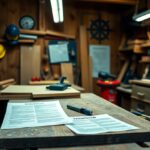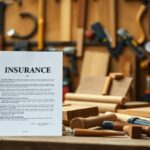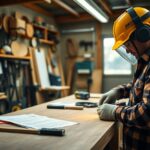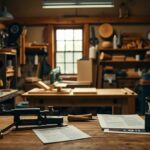Insurance protection for your woodworking shop extends far beyond basic coverage of your building structure. As a woodworking business owner, you need comprehensive protection for your valuable machinery, specialized tools, raw materials, and finished products.
Your workshop faces unique risks, from fire hazards due to wood dust to potential damage from power surges affecting expensive equipment.
Whether you operate from a small custom furniture studio or a large production facility, the right commercial property insurance safeguards your investment and helps you recover quickly from unexpected events that could otherwise halt your operations.
Core Property Coverage
Before you can effectively protect your woodworking business, you need to understand the fundamental elements of commercial property insurance.
Your policy should encompass protection for both physical structures and the valuable equipment inside them.
A comprehensive coverage plan safeguards your investment against common risks like fire, theft, vandalism, and natural disasters, ensuring your business can recover from unexpected setbacks.
Building and Structure Protection
Coverage for your woodworking shop’s physical structure includes the main building, attached structures, and permanent fixtures.
Your policy should account for local building codes, repair costs, and potential upgrades required after a covered loss.
This protection extends to built-in systems like electrical, plumbing, and HVAC, ensuring your workspace remains operational.
Equipment and Machinery Coverage
Core coverage for your woodworking equipment protects your valuable machinery, tools, and specialized equipment.
Your policy should cover both stationary machines like table saws, planers, and CNC equipment, as well as portable power tools and hand tools important to your operations.
Further consideration should be given to coverage limits that match your equipment’s current replacement value.
You’ll want to account for both new and existing machinery, including any custom modifications or upgrades.
Your policy can also include protection for rented or leased equipment, ensuring comprehensive coverage for all tools used in your woodworking operations.
Specialized Woodshop Protection
One necessary aspect of woodshop insurance is specialized protection tailored to your unique business operations.
Your woodworking facility requires specific coverage that addresses the distinct risks associated with woodworking equipment, tools, and processes.
This specialized protection ensures your workshop remains safeguarded against common industry hazards like fire, equipment breakdown, and accidental damage.
Raw Material Insurance
An effective insurance policy should cover your valuable raw materials, from exotic hardwoods to standard lumber inventory.
Your coverage needs to account for material storage conditions, fluctuating market values, and potential damage from moisture, fire, or theft.
This protection helps maintain your business continuity by ensuring you can replace damaged materials quickly.
Finished Product Coverage
Insurance for your completed woodwork projects provides protection from the moment of completion until delivery to your client.
Your policy should cover damages during storage, transportation, and installation, ensuring your craftsmanship remains protected throughout the entire process.
Hence, when selecting finished product coverage, you should consider factors like project value, storage duration, and transportation methods.
Your policy can be customized to include additional protection for high-value custom pieces, exhibition items, or commissioned works.
This comprehensive coverage safeguards your reputation and financial investment in each completed project.

Fire Safety Requirements
Once again, your woodworking shop’s insurance coverage heavily depends on your fire safety measures. Insurance providers will assess your facility’s fire prevention systems, emergency protocols, and safety equipment before determining rates.
You’ll need to demonstrate compliance with local fire codes, maintain proper documentation, and implement regular staff training to secure favorable coverage terms.
Sprinkler Systems and Prevention
Fire sprinkler systems serve as your first line of defense in protecting your woodworking shop. You’ll need to install and maintain appropriate sprinkler coverage throughout your facility, including specialized systems for finishing areas.
Your insurance provider will evaluate the system’s design, water supply adequacy, and inspection records when determining your coverage rates.
Dust Collection Standards
Against the backdrop of workshop safety, your dust collection system plays a vital role in fire prevention. You’ll need to meet specific standards for dust extraction, including proper ventilation, regular maintenance of collection units, and appropriate disposal methods.
Your insurance provider will assess your system’s compliance with NFPA 664 standards and local regulations.
Plus, your dust collection system requires strategic placement of collection points, adequately sized ductwork, and proper airflow management. You’ll need to maintain detailed records of system inspections, filter changes, and cleaning schedules.
Your insurance provider will evaluate these factors along with your emergency shutdown procedures and spark detection systems to assess your overall risk level.
Liability Considerations
Not only must you protect your physical assets, but you also need comprehensive liability coverage for your woodworking shop.
Your business faces various liability risks, from customer injuries to product-related claims. A well-structured liability insurance plan helps safeguard your business against potential lawsuits and financial losses that could arise from accidents or product issues.
Customer and Visitor Protection
With customers and visitors entering your woodworking shop, you need proper protection against potential slip-and-fall accidents or other injuries that might occur on your premises.
Your liability coverage should include adequate limits to cover medical expenses, legal fees, and potential settlements if someone gets injured while visiting your facility.
Product Liability Coverage
Coverage for your finished woodwork products is imperative to protect your business from claims related to defective items or injuries caused by your products after sale.
Your policy should cover design flaws, manufacturing defects, and inadequate warning labels or instructions.
Hence, when selecting product liability coverage, you should consider your product types, production volume, and end-use applications.
Your policy limits need to align with your risk exposure, taking into account factors like custom furniture pieces, architectural elements, or mass-produced items you create.
This coverage becomes particularly important if you sell products to commercial clients or through retail channels.
Business Interruption Insurance
Unlike standard property coverage, business interruption insurance safeguards your woodworking shop’s income when physical damage forces you to temporarily close.
This coverage helps you maintain financial stability during repairs by covering ongoing expenses like payroll, rent, and utilities while your workshop is non-operational.
Income Protection
Income protection under business interruption insurance compensates you for lost revenue based on your workshop’s historical earnings.
You’ll receive coverage for the net income you would have earned during normal operations, helping you maintain cash flow and meet financial obligations while your business recovers from covered property damage.
Recovery Period Coverage
Before selecting your policy, you’ll need to determine an appropriate recovery period for your woodworking shop. This period typically ranges from 30 days to 12 months, depending on your business size and complexity of operations.
Interruption coverage extends until your business returns to normal operations, within your selected recovery period.
You’ll want to consider factors like equipment replacement time, rebuilding requirements, and local permit processes when choosing your coverage duration.
This ensures you have adequate protection throughout your workshop’s restoration phase.
Risk Assessment
Your woodworking shop’s risk profile directly impacts your insurance coverage and premiums. A thorough evaluation helps identify potential hazards, from fire risks associated with sawdust accumulation to equipment-related accidents.
Regular risk assessments demonstrate your commitment to safety and can lead to more favorable insurance terms.
Workshop Layout Evaluation
With proper spacing between machinery, designated storage areas, and clear emergency exits, your workshop layout plays a key role in risk mitigation.
Your insurance provider will assess how your floor plan minimizes fire spread potential and facilitates swift evacuation.
Consider factors like dust collection systems placement and electrical panel accessibility when organizing your space.
Safety Protocol Documentation
Documentation of your safety procedures serves as evidence of your proactive approach to risk management.
Your written protocols should outline equipment operation guidelines, maintenance schedules, and emergency response plans. These documents can strengthen your insurance application and support potential claims.
At each safety review, you should update your documentation to reflect new equipment, modified procedures, or identified risks.
Your detailed records of staff training, equipment maintenance, and incident reports demonstrate your ongoing commitment to workplace safety.
Insurance providers value this systematic approach to risk management when determining coverage terms.
To wrap up
To wrap up, protecting your woodworking shop with comprehensive commercial property insurance gives you the confidence to focus on your craft while knowing your valuable equipment and workspace are secured.
Your investment in specialized tools, machinery, and inventory deserves coverage that specifically addresses the unique risks of woodworking operations.
By choosing the right policy, you’ll have protection against fire, theft, equipment breakdown, and other potential setbacks that could impact your business.
Taking this step helps ensure your workshop can recover and continue operations even after unexpected events.







